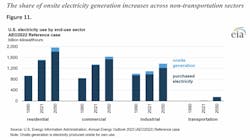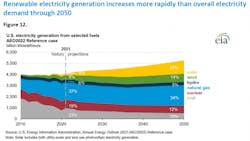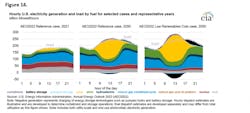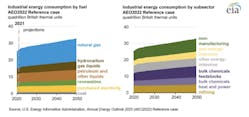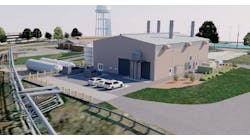Here’s the good news for microgrids. On-site energy will double in the US and renewables will grow faster than any other form of energy through 2050, according to the most recent Annual Energy Outlook (AEO) by the US Energy Information Administration (EIA).
Here’s the bad news. Even after doubling, on-site energy will account for only 6%-8% of electricity consumption. And despite the speedy growth of renewables, they will not catch up to fossil fuels, which will still dominate three decades from now.
Last week, the EIA released the figures at an information session hosted by the Bipartisan Policy Center, a Washington, D.C., think tank.
The bad news comes with a caveat. The EIA’s growth assumptions tend to be conservative. They are based on historic weather patterns and current views on efficiency gains and economic and population growth. Things can change.
More significantly, the EIA considers only enacted government policy. Likely policies do not carry weight nor do private sector initiatives, such as utility integrated resource plans, corporate sustainability goals or community resilience strategies, which certainly drive growth in renewables and on-site energy.
“The value of the projections in the AEO is not that they’re predictions of what will happen, but rather they are model projections of what might happen, given certain assumptions and methodologies,” said Sasha Mackler, energy program executive director of the Bipartisan Policy Center, who served as discussion moderator.
The energy world may look far different from what the EIA numbers say in 30 years — and, in fact, the agency has undershot renewable growth in the past.
But the annual report indicates direction based on a snapshot of today. If the government does nothing else, this is what will happen. So it’s worthwhile taking a look at some of its key findings that influence microgrids.
First, on-site energy.
Over the studied period, on-site generation “expands significantly in the residential commercial and industrial sectors, reducing growth in electricity purchased from centralized generators,” said Angela LaRose, EIA assistant administrator for energy analysis.
By 2050, distributed generation supplies 6% of electricity for households and 8% for commercial buildings under the EIA’s reference case. Much of it comes from solar. In fact, on-site generation from solar photovoltaics (PV) grows faster than purchased grid electricity for buildings in the EIA projections.
This growth occurs despite the EIA’s expectation that PV system costs won’t fall as fast as in the past because of supply chain constraints caused by the pandemic and import restrictions on PV panels.
Microgrids are not discussed in the finding, but because they are a form of on-site energy, the on-site growth figures have meaning to the industry.
The relationship between microgrids and renewable growth
Perhaps more important to microgrids is the overall growth in renewable energy. Microgrids are seen as a key technology to balance intermittency as wind and solar play a larger role on the grid. As wind or solar ebbs and flows during the day, microgrids can quickly ramp their service up or down to help balance supply and demand on the grid. So as more renewables are added, the need for microgrids grows.
The forecast shows the share of renewables more than doubling from 2021 to 2050. Renewables account for over 57% of the 1,000 GW of cumulative electric capacity the EIA sees being added to the grid.
Initially, wind grows more than any other type of renewable, making up over two‐thirds of the increases in electricity generation from 2021 through 2024. With the phaseout of the federal wind production tax credit, that changes. Solar generation ascends to make up almost three‐quarters of the increase in renewable energy.
The dynamics of a renewable grid
The EIA report also looks at how solar will create a midday surplus of energy and what that means to grid dynamics.
“Because solar has essentially zero variable operating costs, its high midday generation levels cause a large decrease in generation from natural gas‐fired combined‐cycle plants during these hours, as well as a slight decrease in generation from coal and nuclear plants. Once the solar generation is not available in the evening hours, the other generators ramp back up to meet demand,” the report said.
The role of batteries grows, too, in the forecast, as they absorb part of that midday solar and discharge it at night, cutting into the need for fossil fuel plants during the evening hours. Battery use reduces the need for natural gas and diesel generation during peak periods, such as hot summer days when the grid needs extra supply.
Fossils hold position
Despite the rapid ascendance of renewables and energy storage, fossil fuels hold steadfast as the most used energy resource through 2050.
“We don’t see liquid fuels and natural gas losing their place as the top two sources of energy in the United States through 2050. That appears to be true under a pretty wide variety of assumptions about economic growth, technology, and energy development cost and prices,” said Stephen Nalley, EIA deputy administrator. “There is still a large established base of fossil fuels use that we simply do not see losing their predominance through 2050, at least not absent some form of policy action.”
Who will be the microgrid customers?
Given that microgrids directly serve retail customers, it’s interesting to look at what parts of the economy will need more or less energy in the coming years under the report’s scenarios.
Manufacturers will see the fastest growth in energy use, twice as fast as any other retail sector. The bulk chemicals industry uses the most energy under the forecast, while the energy needs of steel and glass fall.
Energy use for homes and buildings grows too, but not as fast. The growth is driven by a 23% rise in single-family homes and a more than one-third increase in commercial building space. In both cases, energy efficiency helps curb the growth in energy use.
Throughout the forecast period, electricity is the fastest-growing energy source for buildings.
Air conditioning drives growth in electricity use. In fact, it causes 77% growth in electricity use for homes. Computers, smart phones, televisions, pool pumps and other miscellaneous devices create 20% of the growth for homes.
For businesses, air conditioning also accounts for a 38% rise in electricity use with information technology and office equipment making up 61%.
The full report is available on the EIA website.
Learn more about what’s ahead for microgrids, on-site energy and renewables at Microgrid 2021: Microgrids as Climate Heroes.

